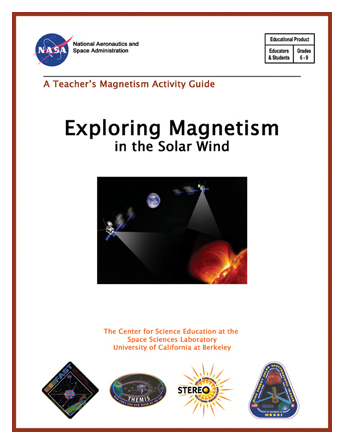 |
Table of Contents
|
Acknowledgements
Doctors Laura Peticolas, Bryan Méndez, Nahide Craig, Janet Luhmann, and Michelle Larson developed and produced these lessons using funding from the Education and Public Outreach program of the NASA STEREO-IMPACT mission while at the Center for Science Education at the Space Sciences Laboratory (CSE@SSL) at the University of California at Berkeley. Several people at CSE@SSL helped with testing, editing, and producing the lessons and the guide. We thank them heartily: Darlene Park, Igor Ruderman, Karin Hauck, and Todd McGill. The teacher feedback we received regarding these activities was invaluable and we are especially grateful for their comments: Tom Shefler, Libby Dalcamo, Lonny Villalobos, and the many teachers who took part in our workshops at national conferences and at CSE@SSL. We also thank Dr. George Craig and the NASA review panel for giving us their comments on this teacher’s guide. And last, but certainly not least, we would like to thank those involved in creating the Lawrence Hall of Science Great Exploration in Math and Science (GEMS) Teacher’s Guides for Grades 6-8, because this teacher’s guide together with the Exploring Magnetism guide, was inspired by the GEMS guides.
Introduction
- back to top -
A Summary of the Teacher’s Guide
This guide is a supplement to the guide Exploring Magnetism, in which students learn about the basic phenomenon of magnetism. The purpose of this guide is for students to apply their newfound knowledge in order to design an important part of a space science spacecraft: the magnetometer boom. The process of designing such a boom imitates the process of NASA engineers.
Included at the beginning of this session is a summary of the session, student objectives, a list of national education standards that the session covers, and a list of materials required for the session. The session is broken into several activities, with each activity outlined for the teacher. In the Background Material section, you can find science background for the lesson, a NASA information sheet about the Sun and Earth’s magnetic fields, and questions and answers that came from a discussion with a NASA IMPACT Boom Engineer, Paul Turin. A glossary can be found after the background section, and at the very end we recommend different resources for purchasing materials and learning more about the NASA mission and science in this guide.
The Science
The Sun sometimes stores so much energy in its magnetic field that when the energy is released, it can accelerate solar wind particles to nearly the speed of light. This tremendous release of energy is sometimes associated with large pressure pulses of solar wind that interact with Earth’s magnetic field, accelerating particles to extremely high energies in the radiation belts, i.e. Van Allen Belts, in Earth’s magnetic field. The solar wind particles moving at near the speed of light can harm astronauts not protected by their spacecraft. The energetic particles in the Van Allen Belts can damage or destroy human-made satellites. In order to understand and predict these phenomena, we need to understand what magnetic fields are.
Currently, NASA is funding the Solar Terrestrial Relations Observatory (STEREO) mission, which involves the building of multiple spacecraft and suites of instruments in order to understand these gigantic releases of energy from the Sun. Scientists involved in the In-situ Measurements of Particles and CME Transients (IMPACT) instrument suite of the STEREO mission are specifically interested in the variation in the Sun’s magnetic field that threads out from the Sun itself, through the planets, and past Pluto. In order to measure the weak magnetic field of the solar wind, an instrument known as a magnetometer is placed far away from the body of a satellite, near the end of a long cylinder called a boom. This magnetometer sits far from the satellite because currents generated in the electrical circuitry in the satellite make local magnetic fields that are larger than the magnetic field of the solar wind.
Using the Teacher’s Guide
STEREO-IMPACT’s education program provides this session and activities on magnetism to inspire your students to learn how electricity and magnetism are connected, and how to apply this knowledge. It is intended to be used following the activities of the teacher guide: Exploring Magnetism.
This session is designed so students can apply their knowledge of magnetic fields to the engineering problem of designing a spacecraft to measure small interplanetary magnetic fields. This is the same task that scientists and engineers have accomplished using the IMPACT instrument suite of the STEREO mission. Activity 1 is a question-answer activity in which the students learn about the magnetic fields of the Sun and Earth. Activity 2 has students experiment with different ways of measuring Earth’s magnetic field direction, using a compass attached to a box with a strong magnet inside. Earth’s magnetic field represents the interplanetary magnetic field and the box with a magnet represents a spacecraft with currents inside. In Activity 3, students act as scientists and engineers at a conference to explain and share their designs and discoveries with other students (scientists and engineers).
All of the activities are inquiry-based. One benefit of such inquiry learning is to teach the students how a scientist performs research by asking questions, testing their ideas, and collaborating with others. Another benefit of inquiry-based activities is to engage the students in the process of learning science.
We estimate that teaching all of the activities in this session would take 2.5 days in an 8th grade classroom with 50-minute class periods
- back to top - |

